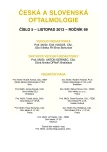Conservative Management Options for Thyroid Disease Induced Diplopia
Authors:
M. Karhanová 1; J. Kalitová 1; O. Vláčil 1; L. Maliňáková 2; L. Drongová 2
Authors‘ workplace:
Oční klinika LF UP a FN, Olomouc, přednosta prof. MUDr. Jiří Řehák, CSc., FEBO
1; Optika – zdravotnické potřeby FN, Olomouc
2
Published in:
Čes. a slov. Oftal., 69, 2013, No. 5, p. 220-224
Category:
Original Article
Overview
Aim:
To focus on the conservative management options for diplopia in patients with thyroid ophthalmopathy in the active and in the “wait-for-operation” stage of the disease. To evaluate the degree of patient knowledge about the treatment options for diplopia and about different types of occlusion. To identify patient preferences when selecting from various management options.
Materials and methods:
This prospective study included patients with thyroid ophthalmopathy and disturbing diplopia in the primary gaze position who were referred for further treatment at the Department of Ophthalmology from January 2010 to June 2012. Twenty five patients (16 women and 9 men) were included for this study during the observation period. At the beginning, the degree of patient knowledge about the treatment options for diplopia and about different types of occlusion was assessed. Subsequently, all patients were informed in detail about different types of black and semi-translucent occlusion. After stabilization of diplopia, Fresnel prism and prism spectacle glasses were tested. At follow-up visits, patient preferences were evaluated.
Results:
Twenty patients were initially informed about monocular patching options by their doctor. Only twelve patients received more specific recommendations on how to cover the eye; in all cases non-translucent plastic or tape patch was recommended. Only one patient used non-translucent occlusion in daily life; ten patients used it occasionally during static activities. None of the patients was informed about semi-translucent occlusion possibilities. At follow-up after two to four months, 19 patients used semi-translucent occlusion in daily life (18 used semi-translucent tape, one used frosted lens). Only one patient continued to use non-translucent occlusion. Five patients used no occlusion and closed one eye when necessary.
Conclusion:
Strabismus surgery in patients with thyroid ophthalmopathy is recommended in the inactive phase of the disease. For patients with diplopia it could be very difficult to overcome the active phase of the disease. In our study, the vast majority of patients in this phase preferred semi-translucent occlusion to non-translucent one.
Key words:
diplopia, restrictive strabismus, thyroid ophthalmopathy, occlusion
Sources
1. Divišová, G.: Strabismus. Praha, Avicenum, 1979, 306 s.
2. Hadid, O.H., Wride, N.K., Griffiths, P.G. at al.: Opaque intraocular lens for intractable diplopia: experience and patients? expectations and satisfaction. Br J Ophthalmol, 2008; 92: 912–915.
3. Iacobucci, I.L., Archer, S.M., Burr B.A. et al. Bangerter foils in the treatment of moderate amblyopia. Am Orthopt J, 2001; 51: 84–91.
4. Karhanová, M., Vláčil, O., Šín, M. et al.: Srovnání metody nastavitelných versus fixních stehů u pacientů s endokrinní orbitopatií. Čes a Slov Oftal, 2012; 68: 207–213.
5. Kikkawa, D.O., Cruz, R.C. Jr., Christian, W.K. et al.: Botulinum A toxin injection for restrictive myopathyKikkawa, D.O of thyroid-related orbitopathy: effects on intraocular pressure. Am J Ophthalmol, 2003; 135: 427–31.
6. Law, K.M., Woo, G.C.: Thyroid disease induced diplopia. Clin Exp Optom, 2009; 92: 30–33.
7. Nardi, M.: Squint surgery in TED – hints and fints, or why Gravesę patients are difficult patients. Orbit, 2009; 28: 245–250.
8. Rutstein, R.P.: Use of Bangerter filters with adults having intractable diplopia. Optometry, 2010; 81: 387–393.
9. Veronneau-Troutman, S.: Fresnel prism and their effects on visual acuity and binocularity. Trans Am Ophthalmol Soc, 1978; 76: 610–653.
10. Woo, G.C., Campbell, F.W., Ing, B.: Effect of Fresnel prism dispersion on contrast sensitivity function. Ophthalmic Physiol Opt, 1986; 76: 610–653.
Labels
OphthalmologyArticle was published in
Czech and Slovak Ophthalmology

2013 Issue 5
Most read in this issue
- Conservative Management Options for Thyroid Disease Induced Diplopia
- Management of Uncontrolled Secondary Glaucoma with ExPRESS Glaucoma Minishunt Implantation
- The Relations of Morphological and Functional Changes in Children with Retinal Dystrophy Disease
- Development of Number of Endothelial Cells after Cataract Surgery Performed by Femtolaser in Comparsion to Conventional Phacoemulsification
